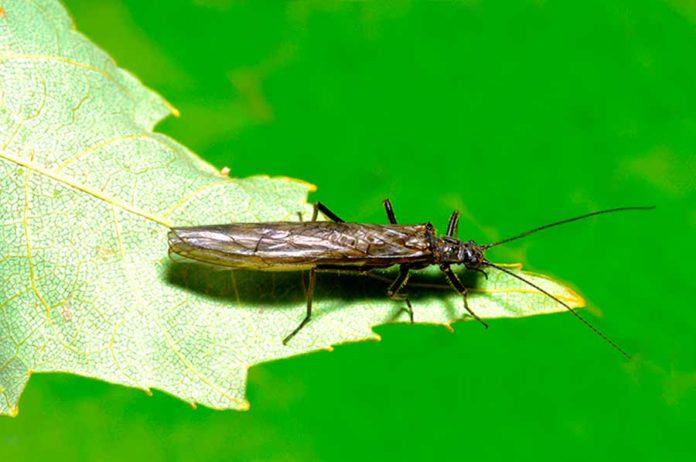Photos by Ted Fauceglia
[Editor’s note: Ted Fauceglia is the country’s foremost photographer of aquatic insects, and he writes the “Natural Reflections” column in each issue of American Angler. Ted is also an FFI Certified Casting Instructor, the author of Mayflies (2004), and he has provided the bug and fly-pattern photography for dozens of books. He has graciously allowed us to republish some of his columns, and we will be sharing Ted’s incredible images and fly-fishing knowledge every month.]
Early Brown Stoneflies (EBS) are one of the earliest Eastern and Midwestern hatches. Beginning in early-to-mid March, after spending the past year hidden in the stream’s bottom debris, the EBS reddish-brown nymphs migrate to the shoreline, crawl out of the water, and morph into adults.
Measuring from a half to three-quarters of an inch in length, adults sport dark, grayish-brown colors that will vary from stream to stream. EBS adults have four highly veined wings that lie uniformly flat over their extended abdomen when at rest. They have six spider-like and conspicuously long antennae.

TF’s Early Brown Stonefly Adult
Hook: 3X-long nymph hook (here, a TMC 200R), sizes 16 and 14.
Thread: Dark Brown, 8/0 or 70-denier.
Tail: Fine grayish-brown deer body hair.
Abdomen Hackle: One chocolate dun hackle.
Abdomen : Natural fur dark hare’s mask dubbing.
Wings: Grayish-brown deer body hair.
Thorax: Natural fur dark hare’s mask dubbing.
Front Hackle: Two chocolate dun hackles
Without question, EBS nymphs get most of the trouts’ attention during their emergence. But there are occasions when the adults are in play. The most productive dry-fly action happens when the fertilized females return to the stream to deposit their eggs. Flying nervously over the water, usually in midstream, the female adults descend to the water, drop their egg-masses, and fly off—repeating the process several times. This activity produces splashy rises. Additionally, during high-water conditions, freshly emerged adults, resting streamside, are pulled into the water by splashing waves and drift downstream. Noisy rises near the shore are a sure sign that’s happening. Later in the hatch, randomly searching an adult pattern will get a few hookups. EBS adult patterns need to cover all of these scenarios.
The use of grade-A hackles makes my pattern highly buoyant and enables me to skate it in short spurts across the surface to mimic the actions of nervous, egg-laying females and or struggling adults trying to get off the water’s surface. Additionally, the pattern’s buoyancy makes it an excellent pocket-water, searching pattern. Tagged way back by a long-time fishing buddy as “The Macho Fly,” the pattern tied in several sizes and color combination has been my favorite adult stonefly and searching pattern since the late 1970s.
Credit: Source link































